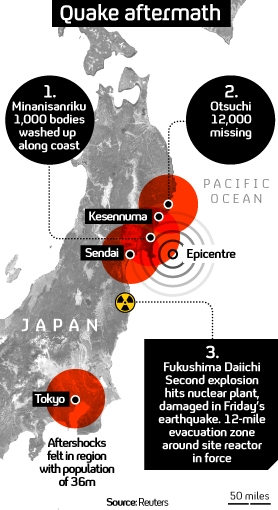Japan disaster: Kesennuma hit by quake, tsunami and fire
 Alex Thomson
Chief Correspondent
Alex Thomson
Chief Correspondent
Boats litter the road after slamming into Kesennuma, one of the worst-hit places in Japan’s quake disaster. Chief Correspondent Alex Thomson reports on the desolation left there by the tsunami.
The city of Kesennuma has reported thousands of its 70,000 citizens missing following Japan‘s devastating earthquake and tsunami. Some of the most shocking video footage to emerge during the aftermath of this catastrophe has come from this place.
It is in northeastern Miyagi prefecture in northern Honshu. Officials in the area have confimed at least 800 in the area are dead but the figure is expected to rise. Local authorities fear more than 10,000 people may have perished. And now rapidly growing forest fires on the peripheries of Kesennuma are threatening to sweep in.
Channel 4 News special report: Japan earthquake, tsunami and nuclear crisis

Many places have suffered on the east coast of Honshu – but few suffer in quite the same way as Kesannuma. As so often with this situation, I’m not sure where to begin in depicting the peculiarity of the pain that this town’s people are now undergoing, reports Channel 4 News Chief Correspondent Alex Thomson.
Oil storage tanks and bunker-fuel pods blackened, melted, contorted by first extreme water, then heat.
At the quayside there is one tiny evacuation vessel still working, brings refugees ashore from Oshima Island across the sound. Greeted by relatives after three days of chaos, Toshiko Mogi says: “See – the fires are getting closer.” And she’s right. Much of the island is clouded in the white wood smoke of a raging forest fire.
Firefighters are ferried in. Refugees out. It is painfully slow. The small open tender which takes perhaps a dozen people at a time. But it is all they have. Overhead three helicopters work relays to drop water over the flames. Like the efforts to extinguish the nuclear fires on this shore, it is not working.
As we leave town, walking through the collapsed buildings and upended pulverised carts, we can see the flames by night. The helicopters clatter on overhead. The tender offloads another group of frightened, tired passengers. But there’s no doubt about it. That woman was right.
Those flames are getting closer.
Read more from Alex Thomson's blog: After the floods, Kesannuma burns
Kesennuma, a fishing port where much of the population are involved in the catching, packaging and transport of tuna, bonito, saury, oysters and shark fin, has only one hospital and it is struggling to cope with the masses of casualties and bodies it is receiving.
It has no power, nor emergency generators. At the time of writing, 410 patients, twice its capacity, are being treated and it has already had 840 emergency patients pass through its doors. Japanese national television is reporting that all the doctors, nurses and staff continue to work not knowing about the status of own family members.
Read more: Japan: Second explosion rocks Fukushima nuclear plant
Bodies washed up as UK rescue team arrives
Officials in Japan‘s north-eastern district of Miyagi said that around 1000 washed up bodies were found scattered across the coastline at Minamisanriku, as further bodies are found on nearby shores.
At least 10,000 people are likely to have died in Miyagi alone following Friday’s devastating earthquake.
A British search and rescue team has arrived at their base, 20km outside Ofunato. The Foreign Office has confirmed the UK has offered nuclear advice, humanitarian assistance and help with disaster victim identification to the Japanese government.